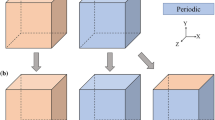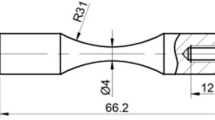Abstract
This chapter investigates microstructure and load sensitive fatigue behavior of Ti-6242 using cyclic crystal plasticity finite element (CPFE) simulations of statistically equivalent image-based microstructures. A wavelet transformation induced multi-time scaling (WATMUS) method (Joseph et al., Comput Methods Appl Mech Eng 199:2177–2194, 2010; Chakraborty et al., Finite Elem Anal Des 47:610–618, 2011; Chakraborty and Ghosh, Int J Numer Methods Eng 93:1425–1454, 2013; Ghosh and Chakraborty, Int J Fatigue 48:231–246, 2013) is used to perform accelerated cyclic CPFE simulations till crack nucleation, otherwise infeasible using conventional time integration schemes. A physically motivated crack nucleation model in terms of crystal plasticity variables (Anahid et al., J Mech Phys Solids 59(10):2157–2176, 2011) is extended in this work to predict nucleation. The dependence of yield strength on the underlying grain orientations and sizes is developed through the introduction of an effective microstructural parameter Plastic Flow Index or PFI. To determine the effects of the microstructure on crack nucleation, a local microstructural variable is defined in terms of the surface area fraction of soft grains surrounding each hard grain or SAFSSG. Simulations with different cyclic load patterns suggest that fatigue crack nucleation in Ti-6242 strongly depends on the dwell cycle hold time at maximum stress.
Access this chapter
Tax calculation will be finalised at checkout
Purchases are for personal use only
Similar content being viewed by others
References
Anahid M, Samal MK, Ghosh S (2011) Dwell fatigue crack nucleation model based on crystal plasticity finite element simulations of polycrystalline Titanium alloys. J Mech Phys Solids 59(10):2157–2176
Bache MR (2003) A review of dwell sensitive fatigue in titanium alloys: the role of microstructure, texture and operating conditions. Int J Fatigue 25:1079–1087
Bridiera F, McDowell DL, Villechaisea P, Mendeza J (2009) Crystal plasticity modeling of slip activity in Ti-6Al-4V under high cycle fatigue loading. Int J Plast 25:1066–1082
Chakraborty P, Ghosh S (2013) Accelerating cyclic plasticity simulations using an adaptive wavelet transformation based multi-time scaling method. Int J Numer Methods Eng 93:1425–1454
Chakraborty P, Joseph DS, Ghosh S (2011) Wavelet transformation based multi-time scale crystal plasticity FEM for cyclic deformation in titanium alloys under dwell load. Finite Elem Anal Des 47:610–618
Deka D, Joseph DS, Ghosh S, Mills MJ (2006) Crystal plasticity modeling of deformation and creep in polycrystalline Ti-6242. Metall Trans A 37(5):1371–1388
Ghosh S, Chakraborty P (2013) Microstructure and load sensitive fatigue crack nucleation in Ti-6242 using accelerated crystal plasticity FEM simulations. Int J Fatigue 48:231–246
Goh CH, Wallace JM, Neu RW, McDowell DL (2001) Polycrystal plasticity simulations of fretting fatigue. Int J Fatigue 23:5423–5435
Groeber M, Ghosh S, Uchic MD, Dimiduk DM (2008) A framework for automated analysis and simulation of 3D polycrystalline microstructures. Part 1: statistical characterization. Acta Mater 56:1257–1273
Groeber M, Ghosh S, Uchic MD, Dimiduk DM (2008) A framework for automated analysis and simulation of 3D polycrystalline microstructures. Part 2: synthetic structure generation. Acta Mater 56:1274–1287
Hasija V, Ghosh S, Mills MJ, Joseph DS (2003) Modeling deformation and creep in Ti-6Al alloys with experimental validation. Acta Mater 51:4533–4549
Joseph DS, Chakraborty P, Ghosh S (2010) Wavelet transformation based multi-time scaling for crystal plasticity FE simulations under cyclic loading. Comput Methods Appl Mech Eng 199:2177–2194
McDowell D, Dunne FPE (2010) Microstructure-sensitive computational modeling of fatigue crack formation. Int J Fatigue 32:1521–1542
Mineur M, Villechaise P, Mendeza J (2000) Influence of the crystalline texture on the fatigue behavior of a 316L austenitic stainless steel. Mater Sci Eng A 286:257–268
Sackett EE, Germain L, Bache MR (2007) Crystal plasticity, fatigue crack initiation and fatigue performance of advanced titanium alloys. Int J Fatigue 29:2015–2021
Sinha S, Ghosh S (2006) Modeling cyclic ratcheting based fatigue life of HSLA steels using crystal plasticity FEM simulations and experiments. Int J Fatigue 28:1690–1704
Sinha V, Mills MJ, Williams JC (2004) Understanding the contributions of normal-fatigue and static loading to the dwell fatigue in a near-alpha titanium alloy. Metall Mater Trans A 35:3141–3148
Stroh AN (1954) The formation of cracks as a result of plastic flow. Proc R Soc Lond Ser A 223:404–414
Venkatramani G, Ghosh S, Mills MJ (2007) A size-dependent crystal plasticity finite element model for creep and load-shedding in polycrystalline Titanium alloys. Acta Mater 55:3971–3986
Williams JC (2006) The evaluation of cold dwell fatigue in Ti-6242. FAA report. The Ohio State University
Acknowledgements
This work has been partially supported by the Air Force Office of Scientific through a grant FA9550-13-1-0062 (Program Manager: Dr. David Stargel) and by the National Science Foundation, Mechanics and Structure of Materials Program through Grant No. CMMI-1100818 (Program Manager: Dr. Thomas Siegmund). This sponsorship is gratefully acknowledged.
Author information
Authors and Affiliations
Corresponding author
Editor information
Editors and Affiliations
Rights and permissions
Copyright information
© 2016 Springer International Publishing Switzerland
About this chapter
Cite this chapter
Ghosh, S., Chakraborty, P. (2016). Microstructure Sensitive Fatigue Crack Nucleation in Titanium Alloys Using Accelerated Crystal Plasticity FE Simulations. In: Trovalusci, P. (eds) Materials with Internal Structure. Springer Tracts in Mechanical Engineering. Springer, Cham. https://doi.org/10.1007/978-3-319-21494-8_4
Download citation
DOI: https://doi.org/10.1007/978-3-319-21494-8_4
Publisher Name: Springer, Cham
Print ISBN: 978-3-319-21493-1
Online ISBN: 978-3-319-21494-8
eBook Packages: EngineeringEngineering (R0)




